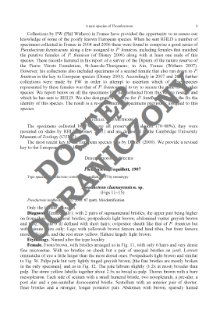
Object
Title: The association of plant parasitic nematodes with fruit crops in Poland as related to some soil properties
Creator:
Szczygieł, Adam (1929–2008) ; Zepp, Alojzy ; Polska Akademia Nauk. Muzeum i Instytut Zoologii
Date issued/created:
Resource type:
Subtitle:
Fragmenta Faunistica, vol. 47, no. 1 ; Plant parasitic nematodes in fruit crops ; Występowanie pasożytniczych nicieni roślin w uprawach sadowniczych w zależności od niektórych czynników glebowych
Publisher:
Museum and Institute of Zoology, PAS
Place of publishing:
Description:
Bibliogr. p. 29-31 ; P. 7-33 ; 25 cm ; Abstarct in Polish. Taxa in Latin.
Type of object:
Abstract:
The survey conducted in 1983-85 in 535 fruit orchards and small fruit plantings, distributed all over the country, revealed association of82 plant parasitic nematode species of eight families with fourteen fruit crops, except strawberry, commonly grown in Poland. All species occurred in the soil in the vicinity of roots. 42 were also encountered in the roots of crops, usually seldom and in low densities in comparison with that in nearby soil. Only some species of the families Pratylenchidae,Hoplolamidae, Tylenchulidaeand Criconematidae occurred relatively abundantly in the roots of some crops. Species of the families Belonolaimidae and Trichodoridae were seldom encountered in the roots and usually in small numbers. No species of the families Longidoridae and Hemicycliophoridae were found in the roots of any fruit crops. The occurrence of the majority of recorded species, expressed either intheir frequency or population density, was significantly related to the surveyed fruit crops and soil type (mechanical composition and acidity). Most of the species preferred light sandy soils and acid or slightly acid ones. However, several species, particularly from the families Hoplolamidae and Tylenchulidae, preferred heavy soils. The paper also discusses the feeding habits of particular taxonomic groups, their harmfulness to fruit crops in temperate climates and their possible economic role in Polish fruit culture.
Relation:
Volume:
Issue:
Start page:
End page:
Detailed Resource Type:
Format:
Resource Identifier:
oai:rcin.org.pl:54534 ; 10.3161/00159301FF2004.47.1.007
Source:
MiIZ PAN, call no. P.256, T. 47 nr 1 ; MiIZ PAN, call no. P.4664, T. 47 nr 1 ; click here to follow the link
Language:
Rights:
Rights Reserved - Restricted Access
Terms of use:
Digitizing institution:
Museum and Institute of Zoology of the Polish Academy of Sciences
Original in:
Library of the Museum and Institute of Zoology of the Polish Academy of Sciences
Projects co-financed by:
Programme Innovative Economy, 2010-2014, Priority Axis 2. R&D infrastructure ; European Union. European Regional Development Fund
Access:
Object collections:
- Digital Repository of Scientific Institutes > Partners' collections > Museum and Institute of Zoology PAS > Scientific Journals
- Digital Repository of Scientific Institutes > Partners' collections > Museum and Institute of Zoology PAS > MIZ PAN Publications > Fragmenta Faunistica
- Digital Repository of Scientific Institutes > Literature > Journals/Articles
Last modified:
Nov 6, 2023
In our library since:
Jun 24, 2015
Number of object content downloads / hits:
80
All available object's versions:
https://rcin.org.pl/publication/61157
Show description in RDF format:
Show description in RDFa format:
Show description in OAI-PMH format:
Objects Similar
Brzeski, Michał W.
Materiały do poznania krajowych nicieni (Nematoda) - pasożytów roślin. 6, Spiralniki (Hoplolaiminae)
Brzeski, Michał Wacław (1937–1999) Państwowe Wydawnictwo Naukowe (1951–1992) Polska Akademia Nauk. Instytut Zoologii
Brzeski, Michał Wacław (1937–1999) Państwowe Wydawnictwo Naukowe (1951–1992) Polska Akademia Nauk. Instytut Zoologii
Zdun, Vsevolod Il'ič (1907–1999)
Brzeski, Michał Wacław (1937–1999) Państwowe Wydawnictwo Naukowe (1951–1992) Polska Akademia Nauk. Instytut Zoologii
Żarnowski, Eugeniusz (1912–1995)
Brzeski, Michał Wacław (1937–1999)
Brzeski, Michał Wacław (1937–1999) Państwowe Wydawnictwo Naukowe (1951–1992) Polska Akademia Nauk. Instytut Zoologii

 INSTYTUT ARCHEOLOGII I ETNOLOGII POLSKIEJ AKADEMII NAUK
INSTYTUT ARCHEOLOGII I ETNOLOGII POLSKIEJ AKADEMII NAUK
 INSTYTUT BADAŃ LITERACKICH POLSKIEJ AKADEMII NAUK
INSTYTUT BADAŃ LITERACKICH POLSKIEJ AKADEMII NAUK
 INSTYTUT BADAWCZY LEŚNICTWA
INSTYTUT BADAWCZY LEŚNICTWA
 INSTYTUT BIOLOGII DOŚWIADCZALNEJ IM. MARCELEGO NENCKIEGO POLSKIEJ AKADEMII NAUK
INSTYTUT BIOLOGII DOŚWIADCZALNEJ IM. MARCELEGO NENCKIEGO POLSKIEJ AKADEMII NAUK
 INSTYTUT BIOLOGII SSAKÓW POLSKIEJ AKADEMII NAUK
INSTYTUT BIOLOGII SSAKÓW POLSKIEJ AKADEMII NAUK
 INSTYTUT CHEMII FIZYCZNEJ PAN
INSTYTUT CHEMII FIZYCZNEJ PAN
 INSTYTUT CHEMII ORGANICZNEJ PAN
INSTYTUT CHEMII ORGANICZNEJ PAN
 INSTYTUT FILOZOFII I SOCJOLOGII PAN
INSTYTUT FILOZOFII I SOCJOLOGII PAN
 INSTYTUT GEOGRAFII I PRZESTRZENNEGO ZAGOSPODAROWANIA PAN
INSTYTUT GEOGRAFII I PRZESTRZENNEGO ZAGOSPODAROWANIA PAN
 INSTYTUT HISTORII im. TADEUSZA MANTEUFFLA POLSKIEJ AKADEMII NAUK
INSTYTUT HISTORII im. TADEUSZA MANTEUFFLA POLSKIEJ AKADEMII NAUK
 INSTYTUT JĘZYKA POLSKIEGO POLSKIEJ AKADEMII NAUK
INSTYTUT JĘZYKA POLSKIEGO POLSKIEJ AKADEMII NAUK
 INSTYTUT MATEMATYCZNY PAN
INSTYTUT MATEMATYCZNY PAN
 INSTYTUT MEDYCYNY DOŚWIADCZALNEJ I KLINICZNEJ IM.MIROSŁAWA MOSSAKOWSKIEGO POLSKIEJ AKADEMII NAUK
INSTYTUT MEDYCYNY DOŚWIADCZALNEJ I KLINICZNEJ IM.MIROSŁAWA MOSSAKOWSKIEGO POLSKIEJ AKADEMII NAUK
 INSTYTUT PODSTAWOWYCH PROBLEMÓW TECHNIKI PAN
INSTYTUT PODSTAWOWYCH PROBLEMÓW TECHNIKI PAN
 INSTYTUT SLAWISTYKI PAN
INSTYTUT SLAWISTYKI PAN
 SIEĆ BADAWCZA ŁUKASIEWICZ - INSTYTUT TECHNOLOGII MATERIAŁÓW ELEKTRONICZNYCH
SIEĆ BADAWCZA ŁUKASIEWICZ - INSTYTUT TECHNOLOGII MATERIAŁÓW ELEKTRONICZNYCH
 MUZEUM I INSTYTUT ZOOLOGII POLSKIEJ AKADEMII NAUK
MUZEUM I INSTYTUT ZOOLOGII POLSKIEJ AKADEMII NAUK
 INSTYTUT BADAŃ SYSTEMOWYCH PAN
INSTYTUT BADAŃ SYSTEMOWYCH PAN
 INSTYTUT BOTANIKI IM. WŁADYSŁAWA SZAFERA POLSKIEJ AKADEMII NAUK
INSTYTUT BOTANIKI IM. WŁADYSŁAWA SZAFERA POLSKIEJ AKADEMII NAUK


































